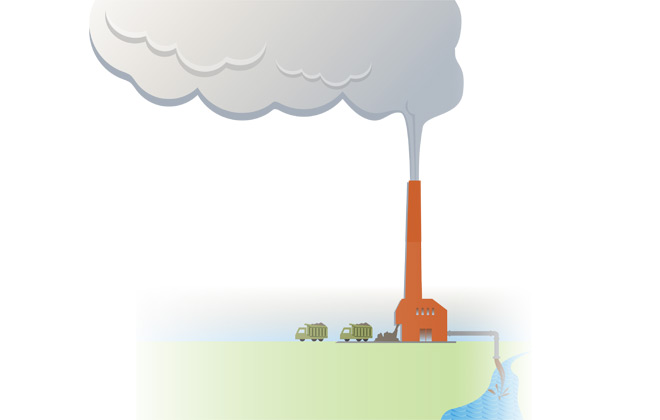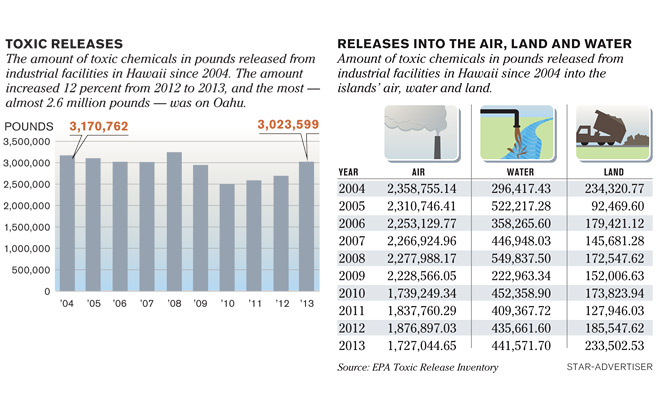Thirty-five Hawaii facilities — mostly power companies, fuel industries and the military — combined to release 3 million pounds of toxic material into the islands’ air, water and land in 2013, representing a 12 percent increase from the year before, according to data from the U.S. Environmental Protection Agency.
|
AIR
2013 total in pounds
1,727,044.65
Air releases can occur through leaking equipment or through stacks, ducts or pipes.
LAND
2013 total in pounds
233,502.53
Land releases include disposal of toxic chemicals into landfills, uncovered holding areas and deep underground injection wells, as well as unintentional spills or leaks on land.
WATER
2013 total in pounds
441,571.70
Surface water releases include discharges into streams, rivers, lakes, oceans and other bodies of water from outflow pipes or open trenches, as well as from stormwater runoff.
TOTAL
2013 total in pounds
3,023,599.21
Includes other releases that were disposed of in other facilities, some chemicals that were recycled, and others used for energy recovery.
|
AES Hawaii Inc., which runs the state’s only coal-fired power plant at its Campbell Industrial Park operation, discharged 662,599 pounds of emissions in 2013, followed by Hawaiian Electric Co.’s Kahe Generating Station, which released 559,112 pounds, and Joint Base Pearl Harbor-Hickam Hawaii, 417,214 pounds.
AES Hawaii Inc. more than doubled the amount of its toxic output in 2013 compared with 2012, when the company released 303,938 pounds of chemicals.
AES Hawaii did not respond to repeated requests for comment.
While emissions from AES Hawaii grew, both HECO’s Kahe Generating Station (down 5 percent) and Joint Base Pearl Harbor-Hickam Hawaii (down 0.4 percent) saw declines from 2012.
HECO’s toxic emissions at its Kahe Generating Station for 2013 represented an even more dramatic decline of 32 percent from its pre-recession peak of 820,974 pounds of emissions in 2007.
HECO customers’ reduced, post-2008 recession demand for energy played a part in cutting down emissions at the Kahe facility. But cool weather and the sulfur content in the fuel that HECO purchases to run its power plants also are critical factors, HECO spokesman Darren Pai said.
"Overall, demand for electricity has not been increasing," Pai said. "It’s dropped for a number of reasons, and economic activity is one component. Much more significantly, what we’ve seen is that people are much more conscious of energy efficiency. Generally speaking, overall Hawaii does continue to rank among the states with the lowest emissions. But we have to keep continuing to look for ways to improve through more renewable energy and natural resources, energy efficiency and conservation. That’s the direction we’re moving in as a state, and it’s the right direction."
Asked about emissions at Joint Base Pearl Harbor-Hickam Hawaii, spokesman Chief Petty Officer John Hageman said in an email that "90 percent of the Navy’s reported amounts are attributed to the release of nutrient (nitrogen), which is a typical byproduct of the Navy’s well-operated, advanced secondary Wastewater Treatment Plant at Fort Kamehameha. The amount of this nutrient compound boosts the Navy’s reportable chemical releases, but it’s important to note that the discharge concentrations and total amounts remain well within stringent regulatory permitted levels allowed by state and federal regulations designed to be protective of our health and environment. The community can be assured that the our strict monitoring practices and use of advanced technology at the Wastewater Treatment Plant at Fort Kamehameha work to ensure a safe and healthy environment for people and marine life in Hawaii."
More than half of Hawaii’s total toxic emissions — 1.7 million pounds — went into the air, according to the EPA, followed by 442,000 pounds that were released into the water, followed by 234,000 pounds that went into the land. Other releases were disposed in other facilities, and some chemicals were recycled, used for energy recovery or treated and contained.
The combined 3 million pounds of toxic material that entered the islands’ environment in 2013 contributed to the 4 billion pounds that were released around the country, according to the EPA.
Some 66 percent of all toxic emissions ended up in America’s land, 19 percent was released into the air, 5 percent ended up in water and 10 percent was transferred to other facilities, according to the EPA.
"We all have a right to know what toxic chemicals are being used and released into our environment, and what progress companies are making to reduce, recycle or prevent waste from being generated in the first place," Jared Blumenfeld, EPA’s regional administrator for the Pacific Southwest, said in a statement.
Interactive map and database:
http://data.staradvertiser.com/toxic Opens in a new tab
TOP POLLUTERS
The top 10 toxin producers in Hawaii were power companies, fuel industries and the military in 2013. Listed are the total toxic releases via land, water and air in pounds.
| Location |
Total release |
| 1. AES Hawaii Inc. |
662,599.80 |
|
| 2. Hawaiian Electric Co. Inc. Kahe Generating Station |
559,112.50 |
|
| 3. Joint Base Pearl Harbor-Hickam Hawaii |
417,214.00 |
|
| 4. Chevron Products Co. Hawaii Refinery |
296,510.40 |
|
| 5. Hawaiian Electric Co. Inc. Waiau Generating Station |
226,335.10 |
|
| 6. Maui Electric Co. Ltd. Kahului Generating Station |
140,000.10 |
|
| 7. Hawaii Electric Light Co. Inc. Hill Generating Station |
130,167.50 |
|
| 8. U.S. Army Schofield Barracks Range Facility |
115,967.50 |
|
| 9. Hawaii Independent Energy LLC |
105,862.80 |
|
| 10. U.S. Marine Corps Base Hawaii |
98,160.00 |
EPA Toxic Release Inventory




